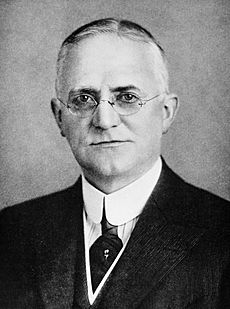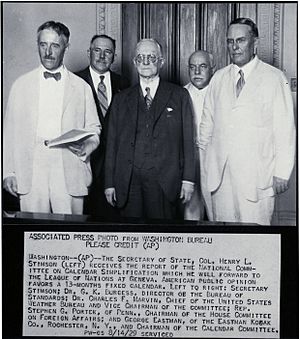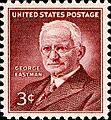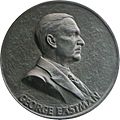George Eastman facts for kids
Quick facts for kids
George Eastman
|
|
|---|---|
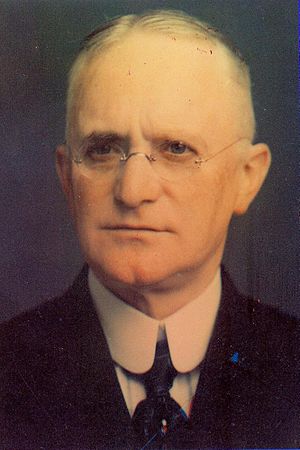 |
|
| Born | July 12, 1854 Waterville, New York, U.S.
|
| Died | March 14, 1932 (aged 77) Rochester, New York, U.S.
|
| Resting place | Ashes buried at Eastman Business Park (Kodak Park) |
| Occupation | Businessman, inventor, philanthropist |
| Known for |
|
| Signature | |
 |
|
George Eastman (born July 12, 1854 – died March 14, 1932) was an American businessman. He founded the Eastman Kodak Company. He made photography much easier for everyone. He did this by helping to make roll film popular.
Eastman was also a very generous person. He gave away huge amounts of money. He helped create the Eastman School of Music and the Rochester Philharmonic Orchestra. He also supported schools of dentistry and medicine at the University of Rochester. He gave money to the Rochester Institute of Technology (RIT) and the Massachusetts Institute of Technology (MIT). He also helped Tuskegee University and Hampton University. These are important universities for Black students in the South. He also funded clinics in London and other European cities to help people who didn't have much money.
The George Eastman Museum is a special place that has been named a National Historic Landmark. George Eastman is honored with two stars on the Hollywood Walk of Fame. This shows how important he was in developing bromide paper, which became a key material for the film industry.
Contents
Early life

George Eastman was born in Waterville, New York. He was the youngest child of George Washington and Maria Eastman. His parents bought a 10-acre farm in 1849. He had two older sisters, Ellen Maria and Katie.
George mostly taught himself, but he did go to a private school in Rochester after he was eight. In the early 1840s, his father started a business school in Rochester, New York. Rochester quickly became a "boomtown" because of new industries.
His father's health got worse, so the family left the farm and moved to Rochester in 1860. His father died in 1862 from a brain problem. To make money and pay for George's schooling, his mother rented out rooms in their home.
His sister Katie got polio when she was young. She died in late 1870 when George was 15 years old. Young George left school early to work and help his family. As his photography business became successful, he promised to repay his mother for all her hard work.
Career
In 1884, Eastman received a patent for the first practical roll film. He had been working on it at home. In 1888, he created the Kodak camera. "Kodak" was a word Eastman made up. It was the first camera designed to use the roll film he had invented.
Eastman sold the camera with enough roll film for 100 pictures. After taking all the pictures, the photographer would mail the camera back to Kodak in Rochester. They also sent $10. The company would develop the film and make prints of each picture. Then, they would put a new roll of film in the camera. Finally, they would send the camera and the prints back to the photographer.
Eastman came up with a famous advertising slogan: "You press the button, we do the rest." This quickly became very popular. At first, no other company could develop the film or sell new film. In 1889, he started selling film stock. By 1896, he was the main supplier of film stock around the world. He officially named his company Eastman Kodak in 1892. As film became standard, Eastman kept coming up with new ideas. Improvements in color film continued even after he died.
During a time when trade unions were growing, Eastman tried to offer good benefits to his workers. In 1910, he started a program where all employees shared in the company's profits. He was seen as a forward-thinking leader for his time. Eastman promoted Florence McAnaney to lead the personnel department. She was one of the first women to hold such a high position in a major U.S. company.
Personal life
George Eastman never got married. He was very close to his mother, his sister, and her family. He had a long, close friendship with Josephine Dickman. She was a trained singer and the wife of a business partner, George Dickman. He became especially close to her after his mother, Maria Eastman, died in 1907. He also loved to travel and enjoyed playing the piano.
Losing his mother, Maria, was very hard for George. He was usually very proper, but for the first time, he couldn't control his feelings in front of his friends. He later explained, "When my mother died I cried all day. I could not have stopped to save my life." His mother was often hesitant to accept his gifts. Because of this, George Eastman felt he could never do enough for her while she was alive. He continued to honor her after her death.
On September 4, 1922, he opened the Eastman Theatre in Rochester. It included a smaller music hall, the Kilbourn Theater. This theater was dedicated to his mother's memory. At his home, the Eastman House, he kept a rose bush. It grew from a cutting from his mother's childhood home.
Later years
Eastman was chosen to be a presidential elector in 1900 and 1916. This meant he voted for the president.
Eastman stayed involved with the Kodak company until he died. He helped a lot with the development of its important research facilities. In 1911, he started the Eastman Trust and Savings Bank.
In the 1920s, he was interested in changing the calendar. He supported the International Fixed Calendar. This calendar had 13 months each year. It was created by Moses B. Cotsworth. Eastman wrote several articles about it. By 1928, the Kodak Company started using this calendar for its business records. They used it until 1989. Eastman was the chairman of the National Committee on Calendar Simplification. His calendar was one of two final choices to be shown to the League of Nations. But after his death and with World War II approaching, the idea was dropped.
He was one of the greatest givers of his time. He donated more than $100 million to different projects. These projects were in Rochester, Cambridge, Massachusetts, and several European cities. He also gave money to two historically black colleges in the South. In 1932, the year Eastman died, $100 million was worth more than $2 billion in 2022.
In 1918, he gave money to start the Eastman School of Music at the University of Rochester. In 1921, he helped create a school of medicine and dentistry there. In 1922, he founded the Rochester Philharmonic Orchestra. He hired Albert Coates as its first music director.

In 1925, Eastman stopped managing Kodak every day. He became the treasurer instead. He focused on helping others, which he had already done a lot of. For example, he gave money to create the Eastman Dental Dispensary in 1916. He was one of the biggest givers, just behind people like Andrew Carnegie and John D. Rockefeller. But he didn't want a lot of attention for his charity work. He focused on building institutions and helping people's health.
In 1926, Eastman gave £200,000 to fund a dental clinic in London. This happened after the chairman of the Royal Free Hospital, George Riddell, 1st Baron Riddell, asked him for help. The UCL Eastman Dental Institute opened on November 20, 1931. Important people like Neville Chamberlain and the American Ambassador attended the opening. The clinic became part of the Royal Free Hospital. It aimed to provide dental care for children from central London who were not well-off. It is now part of University College London. In 1929, he started the George Eastman Visiting Professorship at Oxford. This allows a different important American scholar to teach there each year.
Eastman also funded Eastmaninstitutet. This is a dental care clinic for children that opened in 1937 in Stockholm, Sweden.
Legacy
Eastman was a smart businessman. He focused his company on making film when many other companies started making cameras. By providing good and affordable film to all camera makers, Kodak turned its rivals into business partners.
In 1915, Eastman started a research group in Rochester. Its goal was "to get things done for the community." It also aimed to be an "independent, non-partisan agency for keeping citizens informed." This group is now called the Center for Governmental Research. It still does this important work today.
During his life, Eastman gave $100 million to different groups. Most of his money went to the University of Rochester and the Massachusetts Institute of Technology. He helped them build their programs and facilities. He often used the fake name "Mr. Smith" for these donations. He was one of the biggest givers in the United States during his time. The Rochester Institute of Technology has a building named after Eastman. This is to honor his support and large donations. MIT has a plaque of Eastman on one of the buildings he funded. Students often rub the nose of Eastman's image on the plaque for good luck. Eastman also gave a lot of money to the Tuskegee Institute and the Hampton Institute. These are in Alabama and Virginia.
The Security Trust Company of Rochester managed Eastman's property after he died. All of his remaining money was given to the University of Rochester. The Eastman Quadrangle at the University of Rochester's River Campus is named after him.
Eastman built a large house at 900 East Avenue in Rochester. He would invite friends for dinner and hold private music concerts there. The University of Rochester used the house for different things for many years after he died. In 1949, it reopened as the George Eastman House International Museum of Photography and Film. It has been named a National Historic Landmark. It is now known as the George Eastman Museum.
Eastman's childhood home was saved from being torn down. It was restored to how it looked when he was a child. It is now on display at the Genesee Country Village and Museum.
Patents
- U.S. Patent 226,503 "Method and Apparatus for Coating Plates", filed September 1879, issued April 1880.
- U.S. Patent 306,470 "Photographic Film", filed May 10, 1884, issued October 14, 1884.
- U.S. Patent 306,594 "Photographic Film", filed March 7, 1884, issued October 14, 1884.
- U.S. Patent 317,049 (with William H. Walker) "Roll Holder for Photographic Films", filed August 1884, issued May 1885.
- U.S. Patent 388,850 "Camera", filed March 1888, issued September 1888.
- Eastman licensed, then purchased U.S. Patent 248,179 "Photographic Apparatus" (roll film holder), filed June 21, 1881, issued October 11, 1881, to David H. Houston.
Honors and commemorations
- In 1930, he received the American Institute of Chemists Gold Medal.
- In 1934, the George Eastman Monument was revealed at Kodak Park (now Eastman Business Park).
- On July 12, 1954, the U.S. Post Office released a three-cent commemorative stamp. It marked 100 years since George Eastman's birth. It was first issued in Rochester, New York.
- Also in 1954, to celebrate Eastman's 100th birthday, the University of Rochester put up a meridian marker. This is near the center of Eastman Quadrangle on campus. It was a gift from Charles F. Hutchison, a former associate of Eastman.
- In the fall of 2009, a statue of Eastman was put up near the meridian marker on the Eastman Quadrangle.
- In 1966, the George Eastman Museum was named a National Historic Landmark.
- The auditorium at the Dave C. Swalm School of Chemical Engineering at Mississippi State University is named for Eastman. This honors his inspiration to Swalm.
- In 1968, George Eastman was added to the International Photography Hall of Fame and Museum.
Images for kids
See also
 In Spanish: George Eastman para niños
In Spanish: George Eastman para niños



